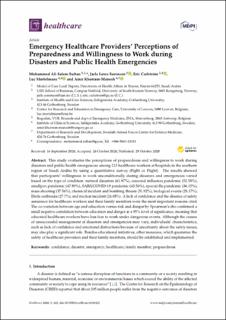| dc.contributor.author | Sultan, Mohammed Ali Salem | |
| dc.contributor.author | Sørensen, Jarle Løwe | |
| dc.contributor.author | Carlström, Eric | |
| dc.contributor.author | Mortelmans, Luc | |
| dc.contributor.author | Khorram-Manesh, Amir | |
| dc.date.accessioned | 2020-11-03T10:01:46Z | |
| dc.date.available | 2020-11-03T10:01:46Z | |
| dc.date.created | 2020-11-02T09:32:43Z | |
| dc.date.issued | 2020 | |
| dc.identifier.citation | Sultan, M. A. S., Løwe Sørensen, J., Carlström, E., Mortelmans, L., & Khorram-Manesh, A. (2020). Emergency Healthcare Providers’ Perceptions of Preparedness and Willingness to Work during Disasters and Public Health Emergencies. Healthcare, 8(4), Artikkel 442. | en_US |
| dc.identifier.issn | 2227-9032 | |
| dc.identifier.uri | https://hdl.handle.net/11250/2686163 | |
| dc.description.abstract | This study evaluates the perceptions of preparedness and willingness to work during disasters and public health emergencies among 213 healthcare workers at hospitals in the southern region of Saudi Arabia by using a quantitative survey (Fight or Flight). The results showed that participants’ willingness to work unconditionally during disasters and emergencies varied based on the type of condition: natural disasters (61.97%), seasonal influenza pandemic (52.58%), smallpox pandemic (47.89%), SARS/COVID-19 pandemic (43.56%), special flu pandemic (36.15%), mass shooting (37.56%), chemical incident and bombing threats (31.92%), biological events (28.17%), Ebola outbreaks (27.7%), and nuclear incident (24.88%). A lack of confidence and the absence of safety assurance for healthcare workers and their family members were the most important reasons cited. The co-variation between age and education versus risk and danger by Spearman’s rho confirmed a small negative correlation between education and danger at a 95% level of significance, meaning that educated healthcare workers have less fear to work under dangerous events. Although the causes of unsuccessful management of disasters and emergencies may vary, individuals’ characteristics, such as lack of confidence and emotional distractions because of uncertainty about the safety issues, may also play a significant role. Besides educational initiatives, other measures, which guarantee the safety of healthcare providers and their family members, should be established and implemented. | en_US |
| dc.language.iso | eng | en_US |
| dc.rights | Navngivelse 4.0 Internasjonal | * |
| dc.rights.uri | http://creativecommons.org/licenses/by/4.0/deed.no | * |
| dc.title | Emergency Healthcare Providers’ Perceptions of Preparedness and Willingness to Work during Disasters and Public Health Emergencies | en_US |
| dc.type | Peer reviewed | en_US |
| dc.type | Journal article | en_US |
| dc.description.version | publishedVersion | en_US |
| dc.rights.holder | © 2020 by the authors. | en_US |
| dc.source.volume | 8 | en_US |
| dc.source.journal | Healthcare | en_US |
| dc.source.issue | 4 | en_US |
| dc.identifier.doi | https://doi.org/10.3390/healthcare8040442 | |
| dc.identifier.cristin | 1843992 | |
| dc.source.articlenumber | 442 | en_US |
| cristin.ispublished | true | |
| cristin.fulltext | original | |
| cristin.qualitycode | 1 | |

